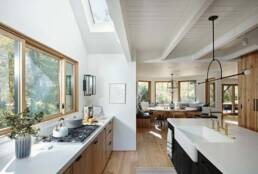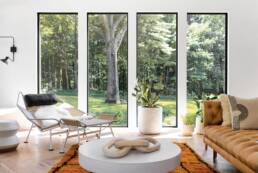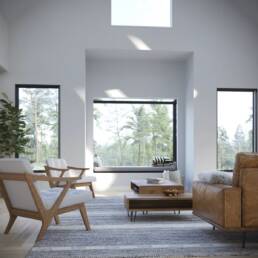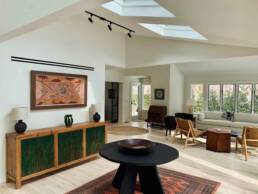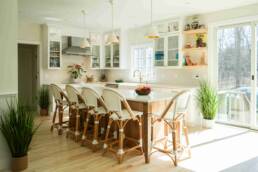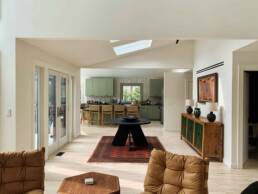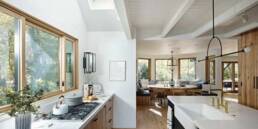In today’s fast-paced world, our homes should be sanctuaries that nurture our mental and physical health. Thoughtful residential design plays a pivotal role in enhancing environmental well-being, creating spaces that promote comfort, sustainability, and a deep connection to nature. By integrating principles such as biophilic design, while focusing on occupant comfort, we can transform our living environments into havens of health and happiness.
The Power of Biophilic Design in Homes
Biophilic design seeks to connect our inherent need to affiliate with nature in the modern built environment by fostering a connection between inhabitants and the natural world. This approach can significantly improve mental well-being and reduce stress levels. Incorporating strategies like connecting with nature indoors, emphasizing natural light, and strategic material selection help craft a more productive and healthy backdrop to people’s lives.
Connecting with Nature Indoors
Integrating natural elements into indoor environments significantly enhances occupants’ well-being. This approach, known as biophilic design, fosters a harmonious connection between people and nature.
Key strategies include:
- Extending Living Areas into Nature: Incorporating accessible outdoor spaces such as gardens, patios, and balconies allows occupants to engage directly with nature, promoting relaxation and mental health.
- Providing Views of Nature: Designing spaces with windows that offer views of natural landscapes can reduce stress and enhance cognitive function. A good residential design can do wonders in oriented views and emphasizing things you want to see while hiding stuff you don’t want to see.
- Incorporating Indoor Plants: Adding indoor plants to living spaces can improve air quality by filtering pollutants and increasing oxygen levels. Plants like peace lilies and snake plants are known for their air-purifying abilities and can contribute to a calming indoor environment.
By thoughtfully integrating these elements, indoor spaces can become sanctuaries that nurture physical and mental health.
Natural Light
Incorporating natural light into residential design enhances both environmental sustainability and occupant well-being. Maximizing daylight reduces energy consumption while improving sleep, mood, and overall health. Here are some key strategies for optimizing natural light in your home:
- Large Windows and Skylights – Expansive glass openings allow maximum daylight penetration, reducing reliance on artificial lighting.
- Strategic Room Orientation – Positioning living spaces to face south (in the Northern Hemisphere) ensures consistent daylight throughout the day. Rooms like offices and art studios like to be on the North side to receive indirect light, while bedrooms and breakfast areas are often positioned to the east. Doing so allows them to enjoy morning sunlight, which can help regulate circadian rhythms by providing natural light at the start of the day.
- Open Floor Plans – Minimizing interior walls allows light to travel freely, creating a brighter, more connected space.
- Reflective Surfaces – Mirrors, glossy finishes, and light-colored walls help distribute natural light more effectively.
- Minimal Window Treatments – Sheer curtains or light-filtering shades let in ample daylight while maintaining privacy.
Integrating these design elements makes homes more energy-efficient, visually appealing, and supportive of overall well-being. Thoughtfully planned natural light solutions enhance comfort while reducing the environmental impact of residential spaces.
Material Selection
In residential design, the thoughtful selection of materials and finishes is pivotal in fostering a connection to nature. A biophilic approach to material selection enhances a space’s aesthetic appeal and significantly contributes to the occupants’ environmental well-being. Below are a few strategies you should consider in selecting materials for your next project:
- Focus on Natural Materials: Incorporating elements such as wood, stone, and marble introduces organic textures and warmth, creating a soothing atmosphere that mirrors the natural environment. For instance, wooden floors and stone countertops can evoke a sense of the outdoors within the home.
- Consider Local Materials: Utilizing regionally sourced materials reduces environmental impact and fosters a sense of place, connecting occupants to the local environment. For example, it’s powerful when a new chimney is made with the same stones from a stone wall lying in ruin on the property.
- Utilize Organic Forms and Patterns: Natural shapes, textures, and patterns spark curiosity, boost creativity, and improve problem-solving. Spaces with soft, organic forms feel inviting, while those with structured patterns encourage reflection, making them visually appealing and awe-inspiring. We naturally prefer these forms, as they help us refocus, reduce stress, and improve concentration. Over time, this connection can deepen our emotional attachment to a place.
By thoughtfully selecting materials and finishes that align with biophilic design principles, residential spaces can become sanctuaries that promote well-being, sustainability, and a profound connection to nature.
Beyond Aesthetics: Prioritizing Occupant Comfort in Home Design
In residential design, prioritizing occupant comfort is essential for creating homes that enhance environmental well-being, productivity, and long-term satisfaction. Factors like thermal comfort, indoor air quality, lighting quality, and acoustics influence physical health, mood, and daily functionality. A well-designed home enhances relaxation and efficiency and supports sustainability by optimizing energy use and reducing reliance on artificial climate control. By integrating thoughtful design strategies, homeowners can enjoy spaces that are not only aesthetically pleasing but also contribute to their overall health and happiness.
Thermal Comfort
Achieving thermal comfort is crucial for a healthy and comfortable living environment. Here are key aspects to consider for improving thermal comfort in your home:
- Passive Design Strategies: Thoughtful design choices such as intelligent insulation, strategic window placement for heat regulation and ventilation, and using materials with high thermal mass (like concrete) can maintain stable indoor temperatures. These passive strategies reduce the need for heating and cooling systems.
- Building Orientation: The orientation of your home can significantly impact thermal comfort. By positioning your home to take advantage of natural light and prevailing winds, you can reduce the need for mechanical heating or cooling and enhance energy efficiency.
- Active Solutions: Strategies like zoning heating and cooling systems or adding ceiling fans can improve comfort and temperature control. Advanced technologies like programmable thermostats allow precise adjustments, optimizing comfort and energy usage.
By considering these factors in the early stages of the design process, homeowners can create a space that maximizes comfort, reduces energy consumption, and supports long-term environmental well-being.
Indoor Air Quality
Enhancing indoor air quality (IAQ) is pivotal for promoting occupant health and environmental well-being in residential design. Consider targeting the following areas to improve your indoor air quality:
- Select eco-friendly building materials, such as reclaimed wood, recycled metals, and low-VOC (volatile organic compounds) products to minimize the emission of harmful chemicals
- Consider ventilation systems that surpass standard requirements to ensure a continuous influx of fresh air, which dilutes indoor pollutants.
- Incorporate natural ventilation through strategic floor plans that facilitate cross-ventilation and promote air circulation.
- Don’t underestimate the power of implementing contaminant control measures. Having an entryway system designed to capture dirt and pollutants prevents the ingress of contaminants into living spaces.
When used together, these strategies foster a healthier indoor environment, enhancing the well-being of residents.
Lighting Quality
Lighting is a powerful tool that can significantly improve your home’s environment and overall well-being. Here are key aspects of lighting to consider for a healthier, more comfortable living space:
- Daylighting: Using natural light through windows and skylights can reduce your reliance on artificial lighting. Natural light brightens your home and boosts your mood and productivity by syncing with your body’s natural rhythms.
- Adjustable Lighting Systems: Flexible lighting systems and individual controls allow you to change the light intensity and direction based on different activities, whether cooking, reading, or relaxing. This adaptability improves comfort and functionality throughout the day.
- Color Temperature: The warmth or coolness of light impacts the atmosphere of a room. Warm lighting (2500K-3000K) creates a cozy environment perfect for winding down, while more astonishing lighting can help you stay alert and focused.
By thoughtfully incorporating these lighting elements into your home, you can create a space that looks great and promotes a healthier, more balanced lifestyle.
Acoustics
Acoustic comfort is a crucial yet often overlooked element in creating a healthy and harmonious home environment. Here’s how you can enhance the acoustics in your living space for better well-being:
- Minimizing Noise Pollution: Excessive external noise can increase stress and disturb sleep, negatively affecting your health. Sound-insulating materials, such as acoustic panels and double-glazed windows, help block out unwanted noise, creating a quieter sanctuary.
- Ambient Noise Levels for Specific Tasks: Different activities require different sound environments. Whether you’re working from home or relaxing, having the flexibility to adjust sound levels can enhance productivity and relaxation. Specialized soundproofing can support this by allowing the right acoustics for each zone.
- Freedom of Choice: Acoustics can be tailored to your needs through design choices such as wall treatments, flooring, and even ceiling design. Thoughtfully separating noisy areas from quiet zones ensures your home remains peaceful and rejuvenating.
By addressing acoustics, you can turn your home into a stress-free retreat, allowing you to unwind and recharge in a tranquil environment.
Conclusion
Thoughtful residential design profoundly impacts environmental well-being, influencing our health, happiness, and connection to the world around us. By embracing principles such as biophilic design and concentrating on occupant comfort, we can create beautiful, functional homes that nurture our well-being and the planet. As we prioritize these elements in our living spaces, we move closer to a future where our homes serve as sanctuaries for both people and the environment. If you want to invest in the environmental well-being of your family with a new home design or home renovation, reach out to us today!

